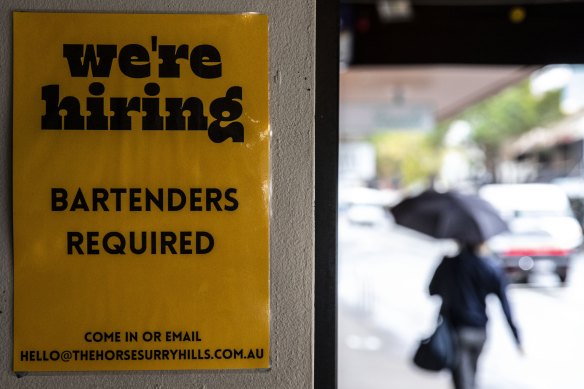This was published 4 months ago
Boomers spend, Zoomers struggle as economic divide widens
By Shane Wright and Millie Muroi
Young and middle-aged Australians are being forced to run down their savings to meet day-to-day expenses while the nation’s boomers enjoy a surge in income that’s enabling them to outspend every other generation.
Data released by the Commonwealth Bank shows people in their 20s, 30s, 40s and early 50s are bearing the brunt of the Reserve Bank’s fight against inflation while those in or approaching retirement are enjoying overseas travel and cafe brunches as their savings swell due to high interest rates.

High interest rates mean younger Australians are feeling economic pain much more than those over 65 years of age. Credit: Dominic Lorrimer
Based on the bank’s 17 million customers, the Commonwealth revealed on Wednesday that people aged under 54 are rapidly eating into their savings.
The worst hit are those aged between 25 and 34 with their savings down by 5.2 per cent over the 12 months to the end of June. Among this group, those in the bottom quarter of incomes have shed 11.2 per cent of their savings.
By contrast, customers over the age of 65 have increased their savings by 7 per cent. Only one other age group, aged between 55 and 64, have lifted their savings, by a modest 1 per cent.
Commonwealth Bank chief economist Stephen Halmarick said the figures highlighted the way young Australians were being forced to bear most of the nation’s economic pain.
“Anyone aged 34 or young is really doing it tough and really having to get by on their savings, but if you’re over 65 you’re doing much better. You likely own your own home, you’re not paying rent, you’re getting really good returns on your savings and the value of your home is going up,” he said.
“There’s a big divergence by age across the economy, and the burden of adjustment is being borne by younger people.”
Younger Australians have also cut their spending. Among the Commonwealth’s customers, 20-24-year-olds have reduced discretionary good expenditure by 1.7 per cent. Those aged between 25 and 34 have cut their discretionary spending by 1 per cent.
The biggest increase in discretionary spending has been among people aged at least 65, up by 4.8 per cent.
Spending on essentials by the bank’s youngest customers has lifted by 3.3 per cent over the year, the smallest increase of any age group.
When Sydney residents Neena and Prabhat Sinha migrated to Australia more than 50 years ago, they had to work hard and save money wherever they could.
“Now that we’re comfortable, and our children are settled, we have time to enjoy life,” Neena, 74, said.
Neena and her husband Prabhat, 81, a retired doctor, have travelled more and kept active by spending on hobbies such as drama classes.

Prabhat and Neena have seen first-hand that older Australians are continuing to spend.Credit: Louise Kennerley
But she had seen the impact of price pressures through grocery bills and knows her children have reduced their spending.
Neena does occasional work as an interpreter, and she and her husband also do community service. However, she finds time to treat herself and said it was clear older, affluent people were continuing to spend on discretionary services.
“Whenever I go to get a manicure, pedicure, or my hair done, I see more older people,” she said.
There are more signs that those dependent on a pay cheque are facing tougher times ahead.
Online job advertisements, as tracked by Jobs and Skills Australia fell by 3.7 per cent in July to be down by 23.1 per cent over the past year.

Online job ads fell in July, taking the fall over the past 12 months beyond 23 per cent.Credit: Jessica Hromas
Ads fell by 7 per cent in Victoria alone to be down by almost a third over the past year, the weakest result of any state or territory. They fell by 3.3 per cent in NSW in July to be off by 26.7 per cent over the past 12 months.
Separate data to be released on Thursday by CreditorWatch shows 87.2 per cent of regions across the country will endure an increase in business failure rates over the next 12 months.
The hardest-hit areas are expected to be western Sydney and south-east Queensland. Almost 8 per cent of businesses in the Bringelly-Green Valley and the Merrylands-Guildford areas of Sydney are now expected to fail by July next year.
Other areas in trouble include Mount Druitt, Canterbury, Auburn and Bankstown in Sydney while Browns Plains, Ormeau-Oxenford, Springfield-Redbank and Surfers Paradise in south-east Queensland all have expected failure rates of at least 7 per cent.
Failure rates are now increasing in every state and territory.
CreditorWatch chief executive officer Patrick Coghlan said the figures proved the tough situation facing many businesses.
“The fact that almost 90 per cent of regions will see an increase in the rate of business failures indicates that the current pressures from interest rates, cost increases and declining consumer demand are being acutely felt right around the country – particularly those areas with younger populations and a higher proportion of businesses in high-risk sectors,” he said.
Cut through the noise of federal politics with news, views and expert analysis. Subscribers can sign up to our weekly Inside Politics newsletter.